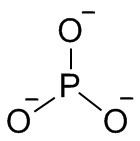Formula PO3− 3 | Molar mass 78.972 g/mol | |
 | ||
Phosphite ion po3 3 lewis dot structure
A phosphite in inorganic chemistry is a salt of phosphorous acid, H3PO3 and following the IUPAC naming recommendations the phosphite ion would be PO3−
3, a salt of P(OH)3.
Contents
- Phosphite ion po3 3 lewis dot structure
- Salts containing phosphite PO3 3
- Salts containing HPO2 3 called phosphonates or phosphites
- Salts containing HPO2OH called hydrogenphosphonates or acid phosphites
- Salts containing H 2P 2O2 5 called diphosphites or pyrophosphites
- Synthesis of phosphite esters
- Use as fungicides
- References
Historically phosphite has referred to salts containing HPO2−
3 and this is because aqueous H3PO3 is not triprotic P(OH)3 but almost exclusively the diprotic HP(O)(OH)2 (IUPAC recommended name of phosphonic acid). The IUPAC-recommended name for the HPO2−
3 ion is phosphonate and this naming convention is becoming more common. In the US the IUPAC naming conventions for inorganic compounds are taught at high school, but not as a 'required' part of the curriculum. A well-known university-level textbook follows the IUPAC recommendations. In practise any reference to "phosphite" should be investigated carefully to determine which naming convention is being employed.
The term phosphite is also used to mean phosphite ester, an organophosphorus compound with the formula P(OR)3.
Salts containing phosphite, PO3− 3
Salts containing PO3−
3 cannot be isolated from aqueous solutions of phosphorous acid. Only salts containing H
2PO−
3 or HPO2−
3 are produced. There are reports of a salt Na3PO3 in older literature and the use of sodium metal to remove the third hydrogen in H3PO3 is mentioned in a textbook. However, if PO3−
3 is produced in aqueous solution or dissolved it would form H
2PO−
3 or HPO2−
3 immediately. Na3PO3 is referred to in many textbooks on Internet sources, often as part of an exercise in naming inorganic compounds, but also as a misprint of the formula for the phosphate salt, Na3PO4.
In contrast to the poor evidence for the existence of PO3−
3, the corresponding arsenic ion, ortho-arsenite, AsO3−
3 is known, and an example is Ag3AsO3 as well as the polymeric meta-arsenite (AsO−
2)
n. The iso-electronic sulfite ion, SO2−
3 is known from its salts.
Salts containing HPO2− 3, called phosphonates or phosphites
Many salts containing this ion are known, and many have been investigated structurally, these include (NH4)2HPO3·H2O, CuHPO3·H2O, SnHPO3 and Al2(HPO3)3·4H2O. The structure of HPO2−
3 is approximately tetrahedral.
HPO2−
3 has a number of canonical resonance forms making it isoelectronic with bisulfite ion, HSO−
3, which has a similar structure.
Salts containing HP(O)2OH−, called hydrogenphosphonates or acid phosphites
Acid or hydrogen phosphites (which the IUPAC recommends be called hydrogenphosphonates), containing the ion HP(O)2OH− such as NH4HP(O)2OH, can be prepared. Hydrogen bonding between anions leads to polymeric anionic structures. Recently some others, RbHPHO3, CsHPHO3, TlHPHO3 have been prepared by reacting phosphorous acid with the metal carbonate. These compounds contain a layer polymeric anion consisting of HPO3 tetrahedra linked by hydrogen bonds. These layers are interleaved by layers of metal cations.
Salts containing H 2P 2O2− 5, called diphosphites or pyrophosphites
Pyrophosphites (diphosphites) can be produced by gently heating acid phosphites under reduced pressure. They contain the ion H
2P
2O2−
5, which can be formulated [HP(O)2O−P(O)2H]2−.
Synthesis of phosphite esters
Organophosphorus compounds called phosphite esters (or sometimes just phosphites) have the formula (RO)3P. They are prepared by reacting phosphorus trichloride (or phosphorus tribromide) with an alcohol and a tertiary amine.
PCl3 + 3 ROH + 3 R′3N → P(OR)3 + 3R′3NHCl
Use as fungicides
Inorganic phosphites (containing HPO2−
3) have been applied to crops to combat fungus-like pathogens of the order Oomycetes. The situation is confusing because of the similarity in name between phosphite and phosphate (a major plant nutrient and fertilizer ingredient), and controversial because phosphites have sometimes been advertised as fertilizers, even though they are converted to phosphate too slowly to serve as a plant's main phosphorus source. Lemoynie and others have described this complicated situation and noted that calling phosphites fertilizers avoided the regulatory complication and negative public perceptions that might have been incurred by registering them as fungicides.
